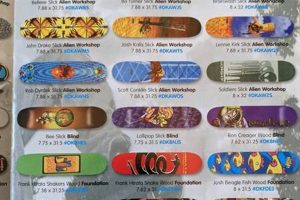A skateboard platform measuring ten inches in width provides an expansive standing surface. This wider design offers increased stability and control, particularly beneficial for skaters with larger feet or those who prioritize balance and predictability in their riding experience. Consider, for instance, a street skater transitioning to wider boards to enhance their landing stability during trick execution.
The enhanced stability afforded by broader platforms promotes confidence and allows riders to explore more complex maneuvers. Historically, wider boards have been favored by transition skaters, those who frequent ramps and bowls, due to the superior control and stability during high-speed carving. This dimension offers a larger sweet spot for foot placement, reducing the likelihood of slipping during critical moments. This, in turn, fosters a more confident and progressive learning curve.
Understanding the dimensions and advantages of wider platforms allows skaters to make informed decisions about equipment selection. This article will delve deeper into the nuances of skateboard deck sizes, exploring their impact on various skating styles, construction materials, and appropriate hardware configurations. It also examines how these considerations interact to shape the overall performance of the skateboard.
Considerations for Utilizing Wider Skateboard Platforms
Selecting the correct skateboard platform is crucial for optimizing performance and comfort. The following tips offer guidance on integrating wider, ten-inch platforms into various skating styles.
Tip 1: Assess Riding Style Compatibility: Determine if the stability afforded by a wide platform aligns with intended skating style. Transition skating, characterized by ramp and bowl riding, often benefits from the enhanced control. Street skating may require a trade-off between stability and maneuverability.
Tip 2: Account for Shoe Size: Foot size significantly impacts comfort and control on a skateboard. Individuals with larger feet generally experience enhanced stability and responsiveness on a wider platform. Conversely, smaller feet may find such platforms less responsive.
Tip 3: Evaluate Truck Width: The width of the skateboard trucks must correspond proportionally to the platform. Trucks that are too narrow will compromise stability and turning ability. Consult manufacturer guidelines for optimal truck size recommendations.
Tip 4: Experiment with Wheelbase: The distance between the trucks, the wheelbase, influences turning radius and stability. A longer wheelbase generally provides increased stability, while a shorter wheelbase allows for tighter turns. Adjust the wheelbase to complement the platform width and intended riding style.
Tip 5: Prioritize Deck Construction: Platform construction materials affect overall durability and responsiveness. High-quality maple wood is a common material, known for its strength and flex. Consider exploring alternatives like composite materials, which offer enhanced durability or reduced weight.
Tip 6: Choose Appropriate Hardware: Ensure that hardware components, such as bolts and risers, are compatible with the wider platform. Longer bolts may be necessary to accommodate thicker decks or the addition of riser pads.
The careful consideration of these factors allows for a tailored skateboard setup, optimizing both performance and comfort. The subsequent sections of this article will delve into advanced topics, including the impact of concave profiles and grip tape selection on overall board control.
1. Stability
The ten-inch skateboard platform is inherently linked to enhanced stability due to its increased surface area. This wider profile offers a more substantial base for foot placement, directly translating to improved balance and control. The increased stability is of particular importance during high-impact maneuvers or when navigating uneven terrain. This relationship between the deck width and stability is not merely theoretical; skaters using wider decks often report greater confidence and reduced instances of losing balance, particularly when learning new tricks.
Consider the practical application of this stability in transition skating. On vert ramps or in bowls, the wider platform provides a more secure foundation for maintaining balance during high-speed turns and aerial maneuvers. This stability is not just about preventing falls; it facilitates a greater range of motion and control, enabling skaters to push the boundaries of their abilities. Further, skaters with larger feet often find wider decks offer a more natural and comfortable stance, further enhancing stability by promoting proper weight distribution.
In summary, the ten-inch skateboard platform’s width is a primary determinant of its stability characteristics. While increased stability is generally advantageous, it is crucial to understand that it can come at the expense of maneuverability, particularly in street skating contexts. The optimal deck width, therefore, depends on an individual’s skating style, skill level, and physical attributes. Recognizing this trade-off is critical for skaters seeking to select equipment that aligns with their specific needs and goals.
2. Foot Placement
Foot placement is a fundamental element of skateboarding, critically influencing balance, control, and the execution of tricks. On a ten-inch skateboard platform, foot placement assumes increased importance due to the expanded surface area and its implications for rider stability and responsiveness.
- Stance Width and Stability
The increased width allows for a wider stance, directly contributing to enhanced stability. A wider stance lowers the center of gravity and provides a more secure base for maintaining balance during landings and transitions. This is particularly beneficial for beginners and those learning challenging tricks. The increased space allows subtle adjustments. The skater can leverage a broader area to regain composure.
- Foot Angle and Board Control
The ten-inch platform offers greater latitude in foot angle. Different angles facilitate varying degrees of responsiveness and turning capability. A more angled front foot can enable sharper turns, while a straighter foot can enhance stability. Experimentation with foot angles can optimize control, catering to specific styles or maneuvers.
- Weight Distribution and Responsiveness
The distribution of weight across the platform is crucial for controlling the board’s responsiveness. The ten-inch deck provides a larger area to manipulate weight distribution, enabling precise control over turning, ollies, and other tricks. Shifting weight becomes more nuanced. The increased platform surface allows for a smoother transfer of energy, leading to more controlled movements.
- Foot Size and Comfort
The ten-inch platform generally accommodates larger shoe sizes more comfortably than narrower decks. This is not merely a matter of physical space; adequate room for foot placement improves board feel and responsiveness. Cramped foot placement leads to decreased control. A properly sized platform allows for natural, uninhibited foot movements, leading to better board feel and more precise control.
Understanding the relationship between foot placement and the ten-inch skateboard platform allows riders to optimize their stance, weight distribution, and overall control. This knowledge enhances both performance and comfort. Careful attention to these elements can lead to a more refined and enjoyable skateboarding experience.
3. Truck Compatibility
The selection of appropriately sized trucks for a ten-inch skateboard platform is a critical factor influencing board performance and rider safety. Ill-matched trucks can compromise stability, turning responsiveness, and overall control, negating the intended benefits of the wider deck.
- Axle Width and Deck Overhang
Axle width should closely match the deck width to ensure optimal leverage and stability. Excessively narrow axles result in instability and reduced turning control, while axles extending significantly beyond the deck edges can create catching hazards. The ideal axle width allows for minimal to no overhang, providing a balanced and predictable ride. Example: Trucks with an axle width of 10 inches are generally recommended for a corresponding deck.
- Hanger Width and Turning Responsiveness
Hanger width, the distance between the truck’s pivot points, influences turning responsiveness. A hanger width disproportionately smaller than the deck width reduces leverage, resulting in sluggish turns. Conversely, a hanger width significantly wider can make the board overly sensitive and prone to instability. A harmonious balance between hanger and deck width is essential for achieving responsive yet controlled turning capabilities.
- Truck Height and Wheel Clearance
Truck height impacts wheel clearance and the board’s center of gravity. Lower trucks provide increased stability but may result in wheelbite, where the wheels contact the deck during turns, causing sudden stops. Higher trucks offer greater wheel clearance but can elevate the center of gravity, reducing stability. Determining the appropriate truck height necessitates careful consideration of wheel size and riding style, often requiring the use of riser pads to achieve optimal clearance.
- Mounting Hole Patterns and Compatibility
Skateboard decks and trucks utilize standardized mounting hole patterns. While most trucks adhere to these standards, compatibility issues can arise, particularly with older or less common truck models. Prior to installation, verifying that the truck mounting holes align precisely with the deck’s drilled holes is crucial for ensuring a secure and reliable connection.
The interplay between these factors underscores the importance of carefully selecting trucks that are appropriately sized and compatible with a ten-inch platform. Neglecting these considerations can severely compromise the performance and safety of the skateboard, hindering the rider’s ability to effectively control the board and execute maneuvers.
4. Transition Riding
Transition riding, characterized by skating on curved surfaces such as ramps, bowls, and pipes, necessitates specific equipment considerations to optimize performance and safety. The selection of a ten-inch skateboard platform is often driven by the unique demands of this discipline, where stability, control, and ample foot placement are paramount.
- Enhanced Stability at High Speeds
Transition riding frequently involves navigating steep inclines and performing aerial maneuvers, both of which demand a stable platform. A ten-inch deck provides a wider base, lowering the center of gravity and minimizing the risk of losing balance at high speeds. This stability is crucial for maintaining control during carving and executing tricks on vert ramps. Example: A skater executing a 540 on a vert ramp benefits from the enhanced stability to maintain balance during rotation and landing.
- Improved Foot Placement Security
The increased surface area of a ten-inch deck allows for a more secure and consistent foot placement. During transition riding, skaters often need to make rapid adjustments to their stance to maintain balance and control. The wider platform provides a larger margin for error, reducing the likelihood of slipping or misplacing a foot during critical moments. This is particularly beneficial for skaters with larger feet or those who prefer a wider stance.
- Greater Control During Carving
Carving, a fundamental technique in transition riding, involves executing smooth, controlled turns on the curved surface. A ten-inch deck provides increased leverage and stability, allowing skaters to maintain consistent pressure and control throughout the turn. This translates to smoother, more controlled carves and a greater ability to maintain speed and momentum. Example: A bowl skater can maintain a consistent arc through a deep carve, utilizing the width for leverage and control.
- Accommodating Larger Body Types
Transition riding often attracts skaters of varying sizes and body types. The ten-inch deck offers a more comfortable and accommodating platform for larger skaters, providing ample space for foot placement and weight distribution. This ensures that skaters of all sizes can effectively control the board and execute maneuvers without feeling cramped or unstable. Example: A taller skater can distribute weight more effectively on the larger deck surface.
These facets of transition riding highlight the advantages of utilizing a ten-inch skateboard platform. While narrower decks may offer greater maneuverability in street skating contexts, the enhanced stability, control, and foot placement security afforded by the wider deck make it a preferred choice for skaters who prioritize performance and safety in transition environments. This equipment choice remains pivotal to the sport’s evolution.
5. Larger Skaters
The dimensions of skateboarding equipment often dictate the accessibility and performance capabilities for diverse body types. Skaters of larger stature or with larger feet find particular benefit from wider platforms, with ten-inch decks offering a substantial advantage in terms of stability and control.
- Enhanced Stability and Balance
Larger individuals generally possess a higher center of gravity. A ten-inch skateboard platform increases the base of support, lowering the center of gravity relative to the contact points with the board. This enhances stability, reducing the likelihood of imbalance during maneuvers and landings. Example: A skater weighing over 200 pounds may find it significantly easier to maintain balance on a ten-inch platform compared to a narrower deck, particularly during transition skating or technical flatground tricks. This fosters confidence.
- Optimized Foot Placement and Comfort
Skaters with larger feet require adequate space for comfortable and secure foot placement. A ten-inch deck provides ample room to position feet naturally, promoting proper weight distribution and board feel. Cramped foot placement can lead to discomfort, reduced board control, and an increased risk of injury. This space promotes a more natural stance. Example: An individual with a shoe size of US 12 or larger may find a ten-inch deck essential for maintaining a comfortable and controlled stance.
- Increased Leverage and Board Control
Larger skaters can leverage the increased surface area of a ten-inch deck to generate more force and control the board’s movements. This is particularly beneficial during ollies, flip tricks, and other technical maneuvers that require precise board manipulation. The larger platform acts as an extension of the skater’s feet, enabling more efficient energy transfer. Example: A larger skater may find it easier to pop higher ollies and execute more controlled flip tricks due to the increased leverage afforded by the wider deck.
- Reduced Risk of Wheelbite
Larger skaters exert more force on the board, increasing the likelihood of wheelbite, where the wheels contact the deck during turns, causing sudden stops. A ten-inch deck, when paired with appropriately sized trucks and wheels, provides increased wheel clearance, mitigating the risk of wheelbite and enhancing safety. Example: A larger skater carving aggressively in a bowl is less likely to experience wheelbite on a ten-inch deck with suitable truck and wheel configurations.
The utilization of a ten-inch skateboard platform by larger skaters addresses fundamental challenges related to stability, comfort, and control. The increased surface area provides a more accommodating and responsive platform, enabling larger individuals to participate in and progress within skateboarding with greater confidence and safety. This is an important consideration within the wider skate community.
6. Advanced Tricks
The execution of advanced skateboarding tricks demands a nuanced understanding of equipment and its impact on performance. A ten-inch skateboard platform influences the feasibility and execution of such maneuvers. This influence stems from the deck’s increased surface area and its effects on stability, foot placement, and overall control. The wider platform provides a larger margin for error, which can be advantageous when attempting complex tricks with unpredictable landings. However, it may also require adjustments in technique due to altered board feel and responsiveness. Consider a skater attempting a double kickflip; the increased stability may aid in maintaining balance during the rotation, but the added weight may require more effort to initiate and control the flip.
Specific advanced tricks are more readily executed with the stability afforded by a wider platform. Transition skating, for example, often involves high-speed aerials and complex rotations on vert ramps and in bowls. The added stability of a ten-inch deck provides a more secure landing surface, allowing skaters to push the boundaries of their trick repertoire. In street skating, certain ledge and rail tricks benefit from the enhanced board control, allowing for more precise foot placement and smoother landings. The relationship between deck width and trick execution is not absolute; skater preference and style play a significant role. Some skaters may prefer the responsiveness of narrower decks for certain tricks, while others find the stability of a wider deck more conducive to their riding style. Ultimately, the choice of deck width is a matter of individual preference and experimentation.
The consideration of deck width is an integral part of the progression of skill. The understanding of this relationship, between the ten-inch platform and execution of advanced tricks, provides skaters with a knowledge base for equipment selection. While the ten-inch platform can be beneficial, it is important to also understand its limitations for various styles of skating. The choice of board is based on individual needs and requirements. The ten-inch platform serves as a tool that skaters can utilize in an effort to enhance and achieve performance goals, while not guaranteeing success on its own.
Frequently Asked Questions
This section addresses common inquiries concerning ten-inch skateboard platforms, providing clarity on their applications, benefits, and limitations.
Question 1: What are the primary advantages of utilizing a ten-inch skateboard deck?
A ten-inch platform offers enhanced stability, increased foot placement area, and improved control, particularly beneficial for transition skating, larger skaters, and those executing complex maneuvers.
Question 2: Are ten-inch decks suitable for all skateboarding styles?
While providing stability, ten-inch decks may not be optimal for all styles. Street skating, for example, often benefits from the greater maneuverability of narrower decks.
Question 3: What truck size is recommended for a ten-inch skateboard deck?
Trucks with an axle width closely matching the deck width, approximately ten inches, are generally recommended for optimal stability and turning responsiveness.
Question 4: Does a ten-inch deck improve the execution of advanced tricks?
The enhanced stability of a ten-inch deck can aid in the execution of some advanced tricks, particularly those involving high speeds or complex rotations. However, it may require adjustments in technique and may not be ideal for all trick types.
Question 5: Is a ten-inch deck appropriate for smaller or younger skaters?
Smaller skaters may find the width and weight of a ten-inch deck challenging to manage. Narrower decks may be more suitable for individuals with smaller feet or lower body mass.
Question 6: What impact does a ten-inch deck have on wheelbite?
A ten-inch deck, when paired with appropriate truck and wheel configurations, can reduce the risk of wheelbite compared to narrower decks.
Selecting the proper deck width hinges on the skater’s individual requirements and performance goals. Ten-inch skateboard platforms present specific advantages, but skaters should carefully consider style, size, and skill level.
The next section will explore the materials science aspect of skateboard deck design.
Conclusion
This exploration has delineated the attributes of the ten-inch skateboard platform, underscoring its suitability for specific skateboarding disciplines and skater profiles. The enhanced stability, increased foot placement area, and improved leverage afforded by this width offer distinct advantages for transition riding, larger skaters, and the execution of advanced maneuvers. Proper truck selection is crucial for optimal performance and safety. The ten-inch skate deck enhances board feel, control, and overall performance. This makes it a considerable choice.
Equipment selection remains a crucial factor in optimizing performance and mitigating risk. Skaters must carefully consider riding style, body type, and skill level to determine the most appropriate deck width. Further research into the nuanced interaction between deck dimensions, truck geometry, and wheel characteristics is encouraged to further refine equipment choices and elevate skateboarding performance. The ten-inch skate deck’s role is to facilitate performance and safety in the skateboarding community. Skaters must consider these factors.




![Best 9 Inch Skate Deck [Guide] For Stability & Tricks Safem Fabrication - Precision Engineering & Custom Manufacturing Solutions Best 9 Inch Skate Deck [Guide] For Stability & Tricks | Safem Fabrication - Precision Engineering & Custom Manufacturing Solutions](https://cruzskateshop.com/wp-content/uploads/2025/06/th-3401-300x200.jpg)


